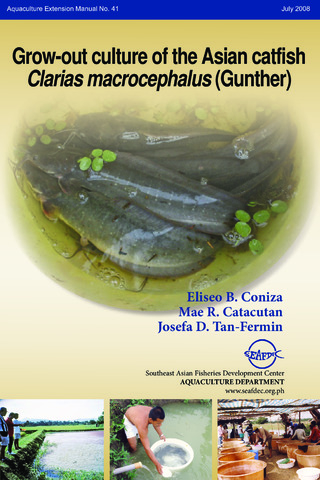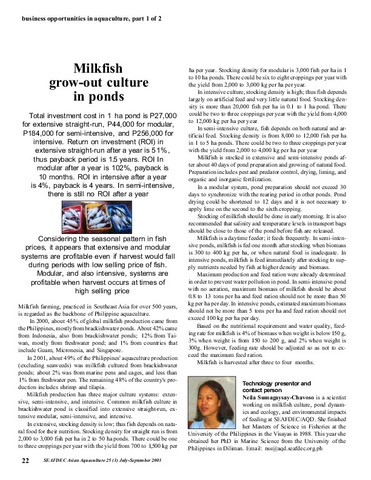Culture and economics of wild grouper (Epinephelus coioides) using three feed types in ponds
| dc.contributor.author | Bombeo-Tuburan, Isidra | |
| dc.contributor.author | Coniza, Eliseo B. | |
| dc.contributor.author | Rodriguez, Eduard M. | |
| dc.contributor.author | Agbayani, Renato F. | |
| dc.date.accessioned | 2014-01-14T02:45:22Z | |
| dc.date.available | 2014-01-14T02:45:22Z | |
| dc.date.issued | 2001 | |
| dc.identifier.citation | Bombeo-Tuburan, I., Coniza, E. B., Rodriguez, E. M., & Agbayani, R. F. (2001). Culture and economics of wild grouper (Epinephelus coioides) using three feed types in ponds. Aquaculture, 201(3-4), 229-240. | en |
| dc.identifier.issn | 0044-8486 | |
| dc.identifier.uri | http://hdl.handle.net/10862/1889 | |
| dc.description.abstract | The performance of wild Epinephelus coioides juveniles was compared by feeding with live tilapia juveniles, fish by-catch, and formulated diet for 5 months in grow-out ponds. To minimize cannibalism, the groupers were graded into small (BW=24.9±7.3 g), medium (45.8±5.7 g), and large (84.1±30.0 g) size groups as block in a Randomized Complete Block Design (RCBD) and reared in nine 350-m2 ponds. To supply the tilapia juveniles, adult tilapia were grown 2 months prior to stocking of grouper at a rate of 15 tilapia/grouper. Grouper fed by-catch were significantly higher (P<0.01) than the other treatments in terms of final length and total production. The quality of by-catch could be gleaned by its efficient feed conversion ratio (FCR) of 1.0 (dry basis), significantly better (P<0.01) than the formulated diet that had an FCR of 2.8. Using by-catch, 47% of the harvest weighed >400 g and only 14% was classified <200 g. The cost of juvenile grouper and feeds represented 88–89% of the total investment in all treatments. Economic sensitivity analysis showed that a combination of improvement in factors such as price of grouper juveniles, feeds, yield, survival, and FCR would result in higher return-on-investment (ROI). When cost and returns were considered, feeding juveniles with by-catch was more profitable because it resulted in net income of Php 361,623/ha/year, an ROI of 155%, and a payback period of 0.4 year. The results clearly show that these economic indicators appear to be attractive, thus making grouper pond culture using by-catch a viable industry. More research efforts should, however, be directed towards developing a cost-effective formulated diet for the grow-out culture of E. coioides. | en |
| dc.language.iso | en | en |
| dc.publisher | Elsevier | en |
| dc.relation.uri | http://citeseerx.ist.psu.edu/viewdoc/download?doi=10.1.1.565.5391&rep=rep1&type=pdf | |
| dc.subject | groupers | en |
| dc.subject | Epinephelus coioides | en |
| dc.title | Culture and economics of wild grouper (Epinephelus coioides) using three feed types in ponds | en |
| dc.type | Article | en |
| dc.identifier.doi | 10.1016/S0044-8486(01)00744-X | |
| dc.citation.volume | 201 | |
| dc.citation.issue | 3-4 | |
| dc.citation.spage | 229 | |
| dc.citation.epage | 240 | |
| dc.citation.journalTitle | Aquaculture | en |
| seafdecaqd.library.callnumber | VF SJ 0669 | |
| seafdecaqd.databank.controlnumber | 2001-16 | |
| dc.subject.asfa | animal nutrition | en |
| dc.subject.asfa | aquaculture economics | en |
| dc.subject.asfa | aquaculture techniques | en |
| dc.subject.asfa | costs | en |
| dc.subject.asfa | diet | en |
| dc.subject.asfa | feeding experiments | en |
| dc.subject.asfa | fish culture | en |
| dc.subject.asfa | feed conversion efficiency | en |
| dc.subject.asfa | rearing techniques | en |
| dc.subject.asfa | yields | en |
| dc.subject.asfa | economics | en |
| dc.subject.asfa | feeding | en |
| dc.subject.asfa | pond culture | en |
Files in this item
| Files | ขนาด | รูป | View |
|---|---|---|---|
|
There are no files associated with this item. |
|||
รายการนี้ปรากฏใน (s)
-
Journal Articles [1221]
These papers were contributed by Department staff to various national and international journals.



